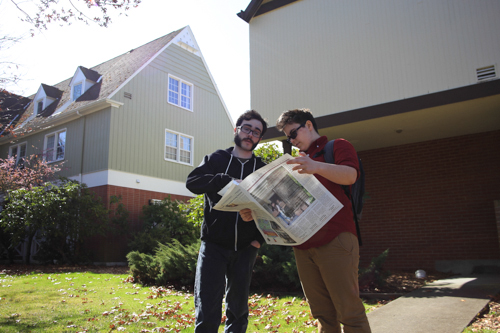This year for the first time a green fee was included in the student government fee that is included in student’s tuition. This fee is part of the Puget Sound vision for sustainability and is an opportunity for students to turn ideas for sustainability into action.
The phrase “Loggers live green” is found all across but students often complain that the campus is not as sustainable as they would like it to be. The green fee was designed to give students the chance to both get more involved with ASUPS and turn ideas into action. Students were given the opportunity to turn in proposals for projects they would like to implement on campus, the green fee will fund these projects.
Seven projects were submitted to ASUPS. Director of Sustainability, Kirsten Fahlbusch, and the Green Fee Review Committee will decide which projects to give funding to.
“The review committee will look over all the applications and their projected costs and then will decide how many projects to fund,” Said Fahlbusch. “The recipients will be notified before the start of winter break, and their projects will start being worked on and implemented at the beginning of Spring semester.”
The Sustainability position is the newest addition to ASUPS. The position was added to serve as a liaison between ASUPS and other sustainability efforts and to promote sustainability programs on campus.
There have been many sustainability efforts on campus in recent years. Seniors may remember the individually portioned cereal boxes that were replaced by bulk dispensers in 2011. Another change, which caused controversy and debate with its implementation, is the Print Green system that seeks to cut back on paper and ink use on campus.
The Print Green program is still widely discussed amongst students, who understand the premise but question the one size fits all system.
“The idea for Print Green is good, but paper use between majors needs to be looked at more closely,” Said Junior Megan Baunsguard. “A chemistry student and politics student do not have the same printing needs.”
The Green Fee is only 3 dollars that makes up a 114 dollar Student Government fee students were charged with in the fall of 2013. ASUPS has a budget of more than 550,000. This money is used to put on programming and to financially support various student groups on campus. The Green Fee generated a 7,308 dollar budget.
With such high tuition students may not notice the addition of a 3 dollar fee and unless students look at an itemized breakdown of charges they may not even be aware they pay a student government fee. As students become aware of the fee they often show a desire to know more about it.
“I’m curious about how they decided the amount of 3 dollars. ” said Junior Elaine Stamp.
This being the first year of the Green Fee it is hard to judge how successful the resulting programs will be, but other student led green initiatives have already had some success. There was a label redesign on the UPS bottled water, in an effort to encourage students to cut back on using bottled water, and the SUB no longer carries the “Green Water” bottled water.
Student government fees are just one of many reasons students should take advantage of the opportunities presented on campus. Students need to be aware of events on campus and opportunities to make a difference, like the Green Fee Project, in order to make the fees a worthwhile part of campus life.
“I would like to know where the fee is going,” said Junior Max Estavo. “If it’s just to increase the budget and students aren’t benefiting from it, it’s not a good use of money.”
Project winners will be announced soon and next spring as projects ideas become implemented students can see their fee at work to improve the campus community and to make Puget Sound a more sustainable campus.



